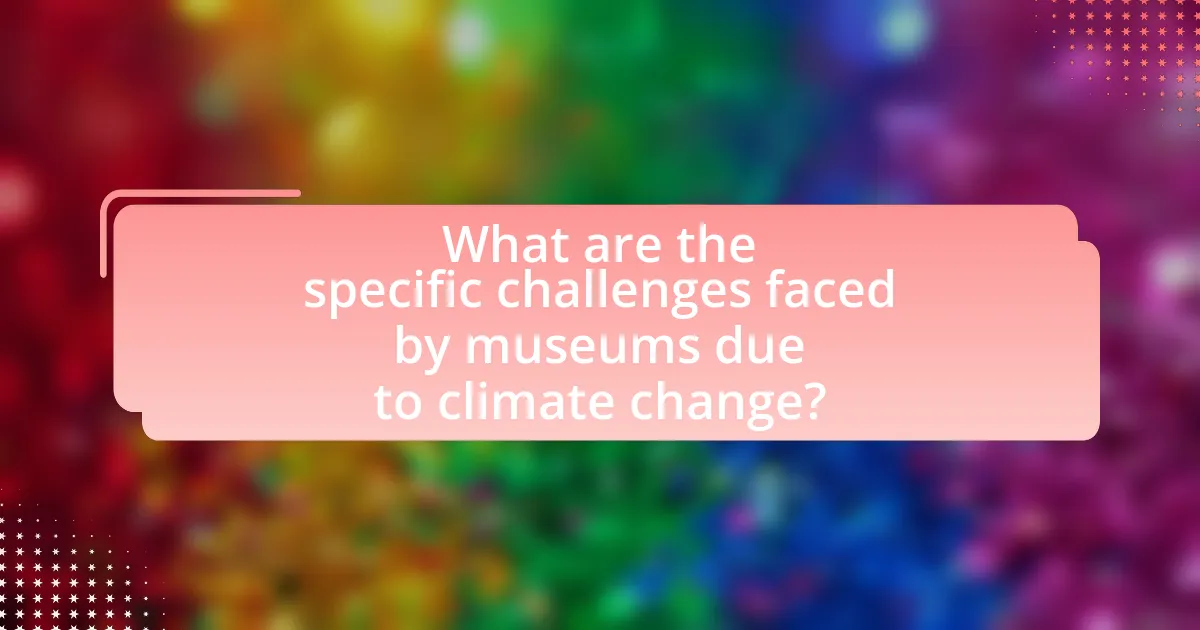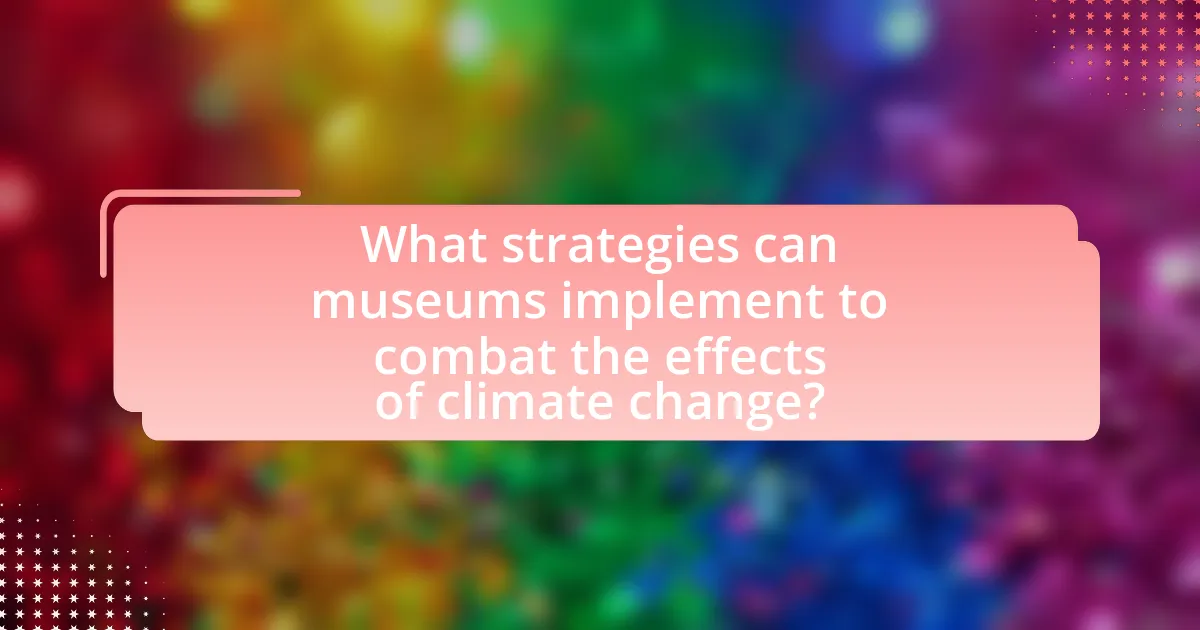The article examines the significant impact of climate change on museum collections, highlighting how fluctuating temperature and humidity levels lead to the deterioration of artifacts. It discusses specific environmental factors contributing to this degradation, such as mold growth, corrosion, and structural damage to materials like textiles, paper, and wood. The article emphasizes the urgent need for museums to adopt effective conservation strategies and climate adaptation measures to protect cultural heritage from the threats posed by extreme weather events and rising sea levels. Additionally, it outlines practical steps museums can take to enhance preservation efforts, including improved environmental controls, staff training, and collaborative partnerships.

What is the Impact of Climate Change on Museum Collections?
Climate change negatively impacts museum collections by causing deterioration of artifacts due to fluctuating temperature and humidity levels. Increased temperatures can lead to accelerated degradation of materials such as textiles, paper, and wood, while higher humidity can promote mold growth and corrosion of metals. For instance, the American Institute for Conservation reports that even small changes in environmental conditions can significantly affect the longevity of collections, emphasizing the need for controlled climate management in museums to preserve cultural heritage.
How does climate change affect the preservation of artifacts?
Climate change negatively impacts the preservation of artifacts by altering environmental conditions such as temperature and humidity. Increased temperatures can accelerate the deterioration of materials like wood, textiles, and paper, while fluctuations in humidity can lead to mold growth and structural damage. For instance, a study by the Intergovernmental Panel on Climate Change (IPCC) highlights that rising sea levels and extreme weather events threaten museum buildings and their collections, leading to potential loss of invaluable cultural heritage. Additionally, the National Park Service reports that artifacts exposed to higher temperatures and humidity levels experience accelerated degradation, emphasizing the urgent need for climate adaptation strategies in museum conservation practices.
What specific environmental factors contribute to deterioration?
Specific environmental factors that contribute to deterioration include temperature fluctuations, humidity levels, light exposure, and air quality. Temperature fluctuations can cause materials to expand and contract, leading to structural damage. High humidity promotes mold growth and corrosion, while low humidity can cause materials to dry out and crack. Excessive light exposure can fade colors and degrade materials, particularly organic ones. Poor air quality, including pollutants and particulate matter, can accelerate chemical reactions that damage artifacts. Studies have shown that maintaining stable temperature and humidity levels significantly reduces deterioration rates in museum collections.
How do temperature and humidity fluctuations impact collections?
Temperature and humidity fluctuations significantly impact collections by accelerating deterioration processes in materials. For instance, high humidity can lead to mold growth and corrosion, while low humidity can cause materials to dry out and crack. Research indicates that fluctuations in temperature and humidity can increase the rate of chemical reactions that degrade organic materials, such as paper and textiles, by up to 50%. Additionally, the American Institute for Conservation recommends maintaining stable environmental conditions to preserve artifacts, as variations can lead to irreversible damage.
Why is it important to understand this impact?
Understanding the impact of climate change on museum collections is crucial because it directly affects the preservation of cultural heritage. Climate change leads to increased humidity, temperature fluctuations, and extreme weather events, which can cause irreversible damage to artifacts. For instance, a study by the American Institute for Conservation indicates that even small changes in temperature and humidity can accelerate deterioration processes in materials such as wood, textiles, and paper. By comprehending these impacts, museums can implement effective conservation strategies, allocate resources wisely, and enhance their resilience against climate-related threats, ensuring the longevity of their collections for future generations.
What are the potential consequences for cultural heritage?
The potential consequences for cultural heritage due to climate change include deterioration, loss of artifacts, and damage to historical sites. Rising temperatures and increased humidity can accelerate the degradation of materials such as wood, textiles, and paper, leading to irreversible damage. For instance, the National Park Service reports that climate change threatens over 30% of cultural resources in U.S. national parks, including archaeological sites and historic structures. Additionally, extreme weather events, such as hurricanes and floods, can physically destroy cultural heritage sites, as seen with Hurricane Katrina’s impact on New Orleans’ historic neighborhoods. These factors collectively jeopardize the preservation of cultural identity and history.
How does this impact public access to museum collections?
Climate change negatively impacts public access to museum collections by increasing the risk of damage to artifacts and necessitating more stringent preservation measures. As climate-related events such as flooding, humidity fluctuations, and temperature extremes become more frequent, museums may need to limit access to vulnerable collections to protect them from deterioration. For instance, the American Alliance of Museums reported that 70% of museums have experienced climate-related damage, leading to restricted public viewing of affected items. This results in reduced opportunities for education and engagement with cultural heritage, ultimately diminishing the public’s access to museum collections.

What are the specific challenges faced by museums due to climate change?
Museums face several specific challenges due to climate change, including increased risk of damage to collections from extreme weather events, rising humidity and temperature levels, and the need for enhanced conservation measures. Extreme weather events, such as hurricanes and floods, can lead to physical damage to buildings and artifacts, as evidenced by the destruction of cultural heritage sites during Hurricane Katrina in 2005. Rising humidity and temperature can accelerate the deterioration of materials, particularly organic items like textiles and wood, which are sensitive to environmental changes. Additionally, museums must invest in more robust climate control systems to protect their collections, leading to increased operational costs and resource demands. These challenges necessitate a proactive approach to preservation and disaster preparedness, highlighting the urgent need for museums to adapt to the realities of a changing climate.
How do extreme weather events threaten museum collections?
Extreme weather events threaten museum collections by causing physical damage, altering environmental conditions, and increasing the risk of pest infestations. For instance, hurricanes can lead to flooding, which damages artifacts and structures, while extreme heat can cause materials like wood and textiles to warp or degrade. According to the American Institute for Conservation, over 70% of museums reported damage from severe weather events in the past decade, highlighting the vulnerability of collections to climate-related threats. Additionally, fluctuating humidity levels can promote mold growth, further endangering delicate items.
What types of disasters pose the greatest risk?
Natural disasters such as floods, hurricanes, and wildfires pose the greatest risk to museum collections. Floods can cause significant water damage to artifacts, as evidenced by the extensive damage to collections during Hurricane Katrina in 2005, which resulted in millions of dollars in losses for museums. Hurricanes, with their high winds and storm surges, can destroy buildings and their contents, as seen in the aftermath of Hurricane Sandy in 2012, where numerous cultural institutions faced severe damage. Wildfires threaten collections through direct heat and smoke damage, exemplified by the 2018 Camp Fire in California, which destroyed the Paradise Museum and its collections. These disasters are exacerbated by climate change, leading to increased frequency and intensity, thereby heightening the risk to cultural heritage.
How can museums prepare for these events?
Museums can prepare for climate change events by implementing comprehensive risk assessment and management strategies. These strategies include conducting vulnerability assessments to identify specific threats to collections, such as increased humidity, temperature fluctuations, and flooding. For instance, the American Institute for Conservation recommends that museums develop disaster preparedness plans that outline procedures for protecting collections during extreme weather events. Additionally, museums should invest in climate control systems and protective storage solutions to mitigate damage from environmental changes. Research indicates that proactive measures can significantly reduce the risk of loss, with studies showing that institutions that adopt such strategies experience fewer incidents of collection damage.
What role does rising sea levels play in the preservation of collections?
Rising sea levels negatively impact the preservation of collections by increasing the risk of flooding and humidity, which can damage artifacts. Flooding can lead to water damage, mold growth, and deterioration of materials such as paper, textiles, and wood. For instance, the National Oceanic and Atmospheric Administration (NOAA) projects that sea levels could rise by up to 6 feet by the end of the century, significantly threatening coastal museums and their collections. This environmental change necessitates urgent adaptation strategies to protect cultural heritage from the adverse effects of climate change.
Which museums are most at risk from flooding?
The museums most at risk from flooding include the Museum of Modern Art in New York City, the British Museum in London, and the Louvre in Paris. These institutions are located in low-lying areas or near bodies of water, making them vulnerable to rising sea levels and extreme weather events linked to climate change. For instance, the Museum of Modern Art is situated in a flood zone, and studies indicate that sea levels in New York could rise by over 6 feet by the end of the century, significantly increasing the risk of flooding. Similarly, the British Museum’s proximity to the River Thames exposes it to potential flooding, especially during storm surges. The Louvre, located near the Seine River, has also faced flooding risks, with historical events demonstrating its vulnerability.
What mitigation strategies can be employed?
Mitigation strategies that can be employed to protect museum collections from the impacts of climate change include implementing climate control systems, enhancing building insulation, and utilizing disaster preparedness plans. Climate control systems, such as HVAC systems, help maintain stable temperature and humidity levels, which are crucial for preserving artifacts. Enhanced building insulation reduces energy consumption and protects collections from extreme weather conditions. Disaster preparedness plans, including risk assessments and emergency response protocols, ensure that museums can effectively respond to climate-related events, safeguarding their collections. These strategies are supported by research indicating that proper environmental controls can significantly extend the lifespan of sensitive materials, as noted in studies by the American Institute for Conservation.

What strategies can museums implement to combat the effects of climate change?
Museums can implement several strategies to combat the effects of climate change, including adopting sustainable practices, enhancing energy efficiency, and improving collection care. By utilizing renewable energy sources, such as solar panels, museums can reduce their carbon footprint significantly. For instance, the Smithsonian Institution has committed to achieving net-zero greenhouse gas emissions by 2050, showcasing a concrete example of sustainability in action. Additionally, museums can invest in climate-controlled environments to protect collections from temperature and humidity fluctuations, which are exacerbated by climate change. The American Institute for Conservation emphasizes the importance of maintaining stable environmental conditions to preserve artifacts effectively. Furthermore, museums can engage in community outreach and education programs to raise awareness about climate change and its impact on cultural heritage, fostering a collective response to this global challenge.
How can museums improve their environmental controls?
Museums can improve their environmental controls by implementing advanced climate monitoring systems that provide real-time data on temperature and humidity levels. These systems enable museums to maintain optimal conditions for the preservation of artifacts, as fluctuations in temperature and humidity can lead to deterioration. For instance, the American Institute for Conservation recommends keeping relative humidity between 30% and 50% and temperature between 65°F and 70°F for most collections. Additionally, museums can invest in energy-efficient HVAC systems that not only reduce energy consumption but also enhance air quality, further protecting sensitive materials. Implementing these measures can significantly mitigate the risks posed by climate change to museum collections.
What technologies are available for monitoring conditions?
Technologies available for monitoring conditions include environmental sensors, data loggers, and remote monitoring systems. Environmental sensors measure temperature, humidity, light levels, and pollutants, providing real-time data essential for preserving museum collections. Data loggers record these environmental parameters over time, allowing for trend analysis and historical data comparison. Remote monitoring systems enable continuous observation and alert museum staff to any deviations from optimal conditions, ensuring timely interventions. These technologies are critical in mitigating the effects of climate change on museum collections by maintaining stable environments that prevent deterioration.
How can museums optimize their storage environments?
Museums can optimize their storage environments by implementing climate control systems that maintain stable temperature and humidity levels. Research indicates that fluctuations in these conditions can lead to deterioration of artifacts; for instance, the American Institute for Conservation recommends keeping relative humidity between 30% and 50% and temperatures between 65°F and 70°F to preserve materials effectively. Additionally, utilizing archival-quality storage materials, such as acid-free boxes and silica gel packets, can further protect collections from environmental damage. Regular monitoring of storage conditions with data loggers ensures that any deviations are promptly addressed, thereby safeguarding the integrity of museum collections against the impacts of climate change.
What best practices should museums adopt for collection care?
Museums should adopt best practices such as maintaining stable environmental conditions, implementing integrated pest management, and conducting regular condition assessments for collection care. Stable environmental conditions, including temperature and humidity control, are crucial as fluctuations can lead to deterioration of artifacts, particularly those sensitive to climate change. Integrated pest management minimizes the risk of infestations that can damage collections, while regular condition assessments help identify and address potential issues before they escalate. Research indicates that museums that implement these practices can significantly extend the lifespan of their collections and mitigate the adverse effects of climate change on artifacts.
How can staff training enhance preservation efforts?
Staff training enhances preservation efforts by equipping personnel with the knowledge and skills necessary to implement effective conservation techniques. Trained staff can identify and mitigate risks associated with climate change, such as fluctuations in temperature and humidity that can damage collections. For instance, a study by the American Institute for Conservation found that museums with trained staff reported a 30% reduction in damage to artifacts due to improved environmental monitoring and control practices. This training ensures that staff are aware of best practices in handling, storing, and displaying items, ultimately leading to better preservation outcomes.
What partnerships can be formed to address climate challenges?
Collaborative partnerships between museums, environmental organizations, government agencies, and academic institutions can be formed to address climate challenges. These partnerships enable the sharing of resources, expertise, and data to develop strategies for climate resilience. For instance, the American Alliance of Museums has initiated collaborations with environmental groups to create guidelines for preserving collections in the face of climate change. Additionally, partnerships with universities can facilitate research on the impacts of climate change on artifacts, leading to informed conservation practices. Such collaborations are essential for enhancing the adaptive capacity of museum collections against climate-related threats.
What practical steps can museums take to ensure the longevity of their collections?
Museums can ensure the longevity of their collections by implementing climate control measures, such as maintaining stable temperature and humidity levels. Research indicates that fluctuations in these environmental factors can lead to deterioration of artifacts; for instance, the American Institute for Conservation recommends keeping relative humidity between 30-50% and temperature around 70°F (21°C) for optimal preservation. Additionally, museums should utilize proper storage materials, such as acid-free boxes and archival-quality display cases, to protect items from light and pollutants. Regular condition assessments and preventive conservation strategies, including pest management and disaster preparedness plans, further enhance the resilience of collections against climate-related threats.


